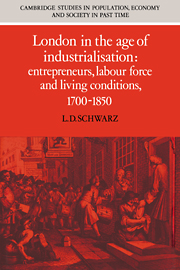Book contents
- Frontmatter
- Contents
- List of figures
- List of tables
- Acknowledgements
- List of abbreviations
- Introduction
- Part I Wealth and occupations in London
- Part II Fluctuations and mortality in the metropolis
- 3 Trends, cycles and wars
- 4 Seasonal fluctuations
- 5 The population of London: the ending of the old regime
- Part III The standard of living and the London trades
- Conclusion: downstream from industrialisation
- Appendices
- Bibliography
- Index
- Cambridge Studies in Population, Economy and Society in Past Time
5 - The population of London: the ending of the old regime
Published online by Cambridge University Press: 11 September 2009
- Frontmatter
- Contents
- List of figures
- List of tables
- Acknowledgements
- List of abbreviations
- Introduction
- Part I Wealth and occupations in London
- Part II Fluctuations and mortality in the metropolis
- 3 Trends, cycles and wars
- 4 Seasonal fluctuations
- 5 The population of London: the ending of the old regime
- Part III The standard of living and the London trades
- Conclusion: downstream from industrialisation
- Appendices
- Bibliography
- Index
- Cambridge Studies in Population, Economy and Society in Past Time
Summary
There is no need to apologise for including a chapter on population in a study of London during the eighteenth and nineteenth centuries; there is, however, a need to apologise for its unashamedly old-fashioned methodology. London was fortunate in having its Bills of Mortality – ‘official’ but highly inaccurate statistics of births and deaths in the central area of the metropolis. Attempts to use them systematically have usually foundered and future work will be based on much more reliable family reconstitution studies. But such work is slow to emerge, while little has been published on the subject since Dorothy George's uncharacteristically uninformative chapter in London Life. The Bills provide some information on the death rate; they provide much more information on causes of death and on the relationship between the death rate, harvests and living standards, and it is these that will be examined in this chapter. The chapter is divided into five parts. The first part examines the various estimates for London's population between 1600 and 1850. The second part considers what can be deduced from the Bills about the death rate. The third part examines the changing causes of death in the capital. The fourth part examines what connection – if any – existed between bad harvests and mortality, while the final parts seek to draw conclusions about mortality and economic growth.
The growth of London
It has become customary to take the figures suggested by Wrigley in 1967 as reasonable estimates for the capital's population.
- Type
- Chapter
- Information
- London in the Age of IndustrialisationEntrepreneurs, Labour Force and Living Conditions, 1700–1850, pp. 125 - 156Publisher: Cambridge University PressPrint publication year: 1992



